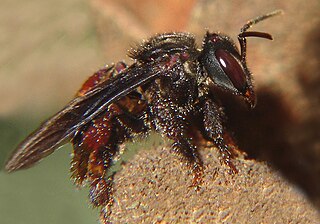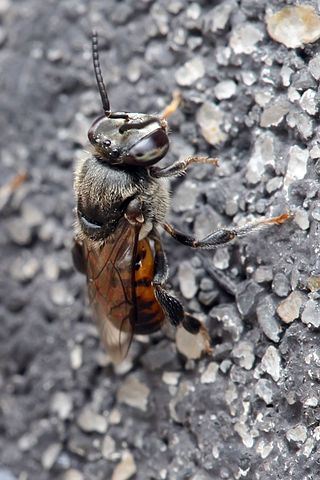Trigonisca buyssoni
Trigonisca buyssoni | ||||||||||||||||||||||
|---|---|---|---|---|---|---|---|---|---|---|---|---|---|---|---|---|---|---|---|---|---|---|
| Научная классификация | ||||||||||||||||||||||
| ||||||||||||||||||||||
| Латинское название | ||||||||||||||||||||||
| Trigonisca buyssoni (Friese, 1902) | ||||||||||||||||||||||
| Синонимы | ||||||||||||||||||||||
|
Trigonisca buyssoni (лат.) — вид безжальных пчёл из трибы Meliponini семейства Apidae. Не используют жало при защите. Хотя жало у них сохранилось, но в сильно редуцированном виде. Вид был впервые описан в 1902 году немецким энтомологом Генрихом Фризе (Heinrich Friese; 1860—1948)[1].
Распространение
Неотропика: Колумбия (Cauca), Перу (Cuzco, Madre de Dios), Эквадор[2][3][4].
Описание
Отмечено опыление растений Prockia crucis (Flacourtiaceae)[5], Roupala montana (Proteaceae), Oxalis neaei (Oxalidaceae), Securidaca sylvestris (Polygalaceae)[6], Pavonia dasypetala (Malvaceae)[7],
Примечания
- ↑ Friese, H. (1902). Neue Meliponiden (Hym.). Z. Syst. Hymenopterol. Dipterol. 2: 382-383 [383].
- ↑ Catalogue of Bees (Hymenoptera, Apoidea) in the Neotropical Region Архивная копия от 13 декабря 2013 на Wayback Machine (англ.)
- ↑ Michener, C.D. (2007) The bees of the world, second edition. Johns Hopkins University Press, Baltimore and London, 953 pp.
- ↑ Roubik, D. W. (1992). Stingless Bees: A guide to Panamanian and Mesoamerican species and their nests (Hymenoptera: Apidae: Meliponinae) pp. 495-524 in Quintero, D. & A. Aiello (ed.) Insects of Panama and Mesoamerica. Selected Studies. Oxford: Oxford University Press 692 pp. [501, 503, 509, 513, 517, 518, 523] (? uncertain identity [error, does not exist in Panama], key, taxonomic note, synonymy, geographic range, diagnosis, nesting site: in liana, adventitious root, tree - citation, nest entrance, behavior, figures: hind tibia, head; ? uncertain identity, as Trigonisca aff. buyssoni, key, diagnosis, nesting site: in tree)
- ↑ Bullock, S. H., Martínez del Rio, C. & Ayala, R. (1989). Bee visitation rates to trees of Prockia crucis differing in flower number. Oecologia (Berl.) 78: 389-393 [392] (? uncertain identity, as Trigona buyssoni [error, does not exist in Mexico], geographic record, size, pollen foraging behavior, pollen foraging: Prockia crucis (Flacourtiaceae), relative abundance)
- ↑ Heithaus, E. R. (1979). Flower visitation records and resource overlap of bees and wasps in northwest Costa Rica. Brenesia 16: 9-52 [41] (? uncertain identity, as Trigona (Hypotrigona) buyssoni [error, does not exist in Costa Rica], flower records: Roupala montana (Proteaceae), Oxalis neaei (Oxalidaceae), Securidaca sylvestris (Polygalaceae))
- ↑ Roubik, D. W. (1982). The ecological impact of nectar-robbing bees and pollinating hummingbirds on a tropical shrub. Ecology 63 (2): 354-360 [356] (? uncertain identity, as Trigona (Trigonisca) buyssoni, [error, does not exist in Panama], nectar foraging behavior, robbing, flower record: Pavonia dasypetala (Malvaceae))
Литература
- Albuquerque, P. M. C. & Camargo, J. M. F. (2007). Espécies novas de Trigonisca Moure (Hymenoptera, Apidae, Apinae). Rev. Bras. Entomol. 51 (2): 160—175 [160].
Ссылки
- Список таксонов на BioLib (англ.)
- eol.org



